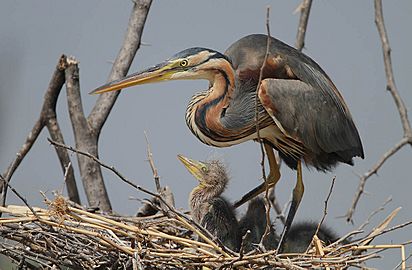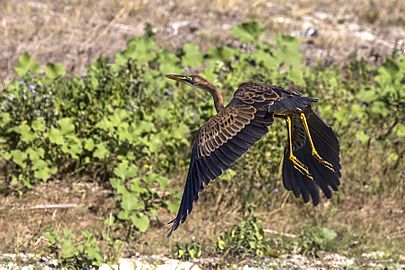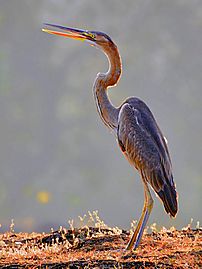Purple heron facts for kids
Quick facts for kids Purple heron |
|
|---|---|
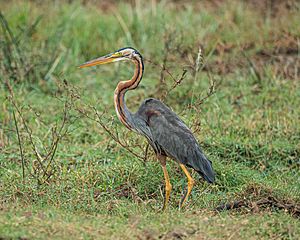 |
|
| Adult, Bundala National Park, Sri Lanka | |
| Conservation status | |
| Scientific classification | |
| Genus: |
Ardea
|
| Species: |
purpurea
|
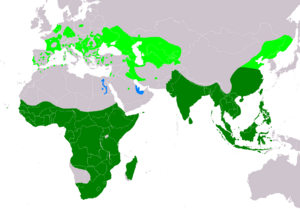 |
|
| Range of A. purpurea Breeding Resident Non-breeding | |
The purple heron (Ardea purpurea) is a tall, wading bird from the heron family. Its scientific name comes from Latin words meaning "heron" and "purple colored." These birds live in Africa, central and southern Europe, and parts of Asia.
Some purple herons travel long distances between their summer breeding grounds and warmer winter homes. This is called migration. Other groups, especially those in Africa and tropical Asia, tend to stay in one place.
Purple herons look a bit like the more common grey heron. However, they are slightly smaller and have darker, reddish-brown feathers. They are also shyer birds. They prefer to live near water in places with lots of plants, like reed beds. They hunt for food like fish, frogs, small animals, and insects. They either sneak up on their prey or wait quietly for it to appear.
Purple herons often nest together in groups called colonies. They build large nests from reeds or sticks near the water's edge. A female heron usually lays about five bluish-green eggs. Both parents take turns sitting on the eggs to keep them warm, which is called incubation. The chicks hatch after about four weeks and can fly about six weeks later.
Even though the number of purple herons is slowly going down, mainly because their wetland homes are disappearing, experts say they are a "least concern" species. This means they are not currently in danger of dying out.
Contents
What Does a Purple Heron Look Like?
The purple heron is a large bird. It stands about 70 to 94 centimeters (28 to 37 inches) tall. Its wings can spread out between 120 and 152 centimeters (47 to 60 inches). Even though it's tall, it's quite slender, weighing only about 0.5 to 1.35 kilograms (1.1 to 3 pounds).
You can tell it apart from the grey heron by its darker, reddish-brown feathers. Adult purple herons have a black forehead and a dark stripe down the back of their neck. The sides of their head and neck are a warm, buff-chestnut color with dark stripes. Their back is an oily brown, and their tail is brownish-grey. The front of their neck is lighter, with some streaky feathers.
Their beak is long, straight, and strong, usually brownish-yellow. It gets brighter when they are ready to breed. Their eyes are yellow, and their legs are brown in front and yellowish behind.
Sounds and Posture
The purple heron makes a harsh "frarnk" sound. It's quieter and higher-pitched than the grey heron's call. They are generally not very noisy birds.
Their head and neck are more slender and snake-like than the grey heron's. They also have very long toes. Unlike the grey heron, they often stand with their neck stretched out at an angle. Even young chicks tend to stand this way.
Types of Purple Herons (Taxonomy)
There are a few different types, or subspecies, of purple herons. They are found in different parts of the world:
- A. p. purpurea: This is the main type. It lives in Africa, Europe (as far north as the Netherlands), and southwestern Asia.
- A. p. bournei: This type is sometimes called Bourne's heron. It lives in the Cape Verde Islands. Some experts think it might even be a separate species.
- A. p. madagascariensis: This type is found only in Madagascar.
- A. p. manilensis: This type lives in Asia, from India all the way to the Philippines and Indonesia. It also goes north into Russia.
-
Juvenile A. p. purpurea, Danube delta, Romania
-
Immature A. p. manilensis, Maharashtra, India
-
Upright A. p. manilensis in North Sulawesi, Indonesia showing long toes
Where Purple Herons Live and Their Homes
Purple herons are found across a wide area, including Europe, Asia, and Africa. The western herons live from Portugal across central and southern Europe and parts of North Africa. In Africa, they breed in Senegal and down the east coast, as well as in Madagascar. The eastern herons live from India east to China and the Philippines.
Migration and Habitat
Between August and October, herons from Europe fly south to warmer parts of Africa for the winter. They return north in March. Sometimes, they fly a bit too far north and end up in places like Britain. Herons in Asia mostly stay in one place, but some from the north fly south for winter. African herons usually do not migrate.
Purple herons like to live in marshes, lagoons, and lakes that have lots of plants around them. They especially love places with thick reed beds. They can also be found near mudflats, river banks, ditches, and canals.
Behaviour and Life Cycle
Purple herons fly slowly, with their neck pulled back and their long legs trailing behind. This is how herons and bitterns fly, which helps tell them apart from storks or cranes that fly with their necks stretched out.
They are shy birds and spend less time out in the open than grey herons. They prefer to hide in reed beds. Their long toes help them walk on floating plants. They rarely perch in trees, preferring to rest on the ground.
Hunting and Diet
Purple herons are most active in the morning and evening. They rest with other birds during the middle of the day and at night. However, they are more active during the day when they are raising their young.
They hunt in shallow water, catching prey with their strong beaks. They often wait very still for food or slowly sneak up on it. Their diet mainly includes fish, small mammals, and amphibians like frogs. They also eat young birds, snakes, lizards, crustaceans, water snails, insects, and spiders. Common insects they eat include beetles, grasshoppers, and dragonflies.
Reproduction and Nesting
Purple herons usually nest in colonies with other herons, but sometimes they nest alone. They build large nests from dead reeds, sticks, or other materials they can find. These nests are usually in reed beds or low bushes near large lakes or wetlands.
The eggs are bluish-green and are about 56 by 45 millimeters (2.2 by 1.8 inches) in size. A female usually lays four or five eggs, but sometimes up to eight. Both parents share the job of sitting on the eggs, which takes about 24 to 28 days. They also both help care for the young chicks.
When an adult brings food, the chicks pull on its beak, and the parent brings up food from its throat onto the nest. Sometimes, the young birds take food directly from the parent's beak. The young herons learn to fly at about six weeks old and become independent at two months. After that, they spread out to new areas.
Conservation Status
Experts believe there are between 270,000 and 570,000 purple herons in the world. Their numbers are slowly going down. However, the International Union for Conservation of Nature says the purple heron is a "least concern" species. This means their decline is not fast enough to put them in a more threatened group right now.
The biggest danger to purple herons is the draining and disturbance of their wetland homes. This includes the destruction of the reed beds where they live. The purple heron is protected by an agreement called the Agreement on the Conservation of African-Eurasian Migratory Waterbirds (AEWA).
See also
 In Spanish: Garza imperial para niños
In Spanish: Garza imperial para niños



